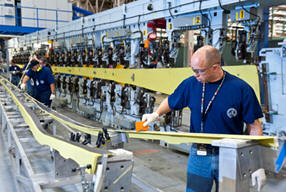|
|||||||||||||||||
|
|
|
|||
|
Boeing Increases
Production On The B-737 To Thirty-Five Airplanes A Month By Bill Goldston |
||||
 |
October 19, 2011 - Boeing began building the first
Next-Generation 737 at the program's new production rate
of 35 airplanes a month. The rate is increasing from
31.5 airplanes a month to meet worldwide market demand
for the best-selling single-aisle airplane.
Employees loaded chords and webs manufactured by the
Boeing Fabrication division into the company's newest
automated spar assembly tool, the first visible step in
the final assembly of the airplane. The parts were then
joined to make a spar, the main support structure for
the wings.
"The start of spar assembly today demonstrates the
progress the 737 team has made," said Beverly Wyse, vice
president and general manager of the 737 program. "This
is part of the series of rate increases to meet customer
demand for the most popular airplane in aviation
history." |
|||
|
Boeing has
taken a three-fold approach to prepare for the rate increases on
the 737 program. The company is making production processes more
efficient by working with employee process improvement teams,
increasing the production capacity with capital investments such
as a new wings system installation line in the Renton factory
and making the site footprint more efficient by moving some
production areas, expanding others and decommissioning outdated
equipment.
The
automated spar assembly tool used to build the first spar is the
ninth such machine at the Renton factory, drilling about 1,700
holes and inserting fasteners to make the spar. The tool
increases the 737's wing-building capacity and is an example of
one of many facilities changes happening at the Renton site to
increase capacity and prepare for rate increases.
The 737
production rate will increase to 38 airplanes a month in the
second quarter of 2013 and to 42 airplanes a month in the first
half of 2014. The Boeing 737 is a short- to medium-range,
twin-engine narrow-body jet airliner. Originally developed as a
shorter, lower-cost twin-engine airliner derived from Boeing's
707 and 727, the 737 has developed into a family of nine
passenger models with a capacity of 85 to 215 passengers. The
737 is Boeing's only narrow-body airliner in production, with
the -600, -700, -800, and -900ER variants currently being built. The 737 series is the best-selling jet airliner in the history of aviation. The 737 has been continuously manufactured by Boeing since 1967 with 6,819 aircraft delivered and 2,109 orders yet to be fulfilled as of June 2011. 737 assembly is centered at the Boeing Renton Factory in Renton, Washington. Many 737s serve markets previously filled by 707, 727, 757, DC-9, and MD-80/90 airliners, and the aircraft currently competes primarily with the Airbus A320 family. There are, on average, 1,250 Boeing 737s airborne at any given time, with two departing or landing somewhere every five seconds. |
||||


